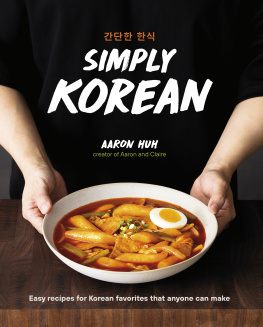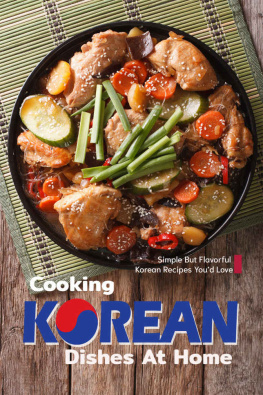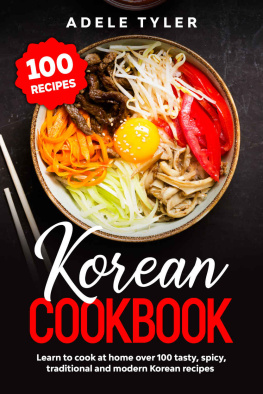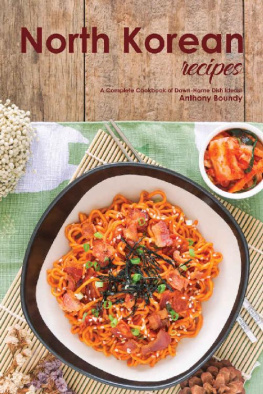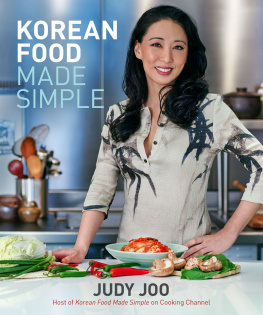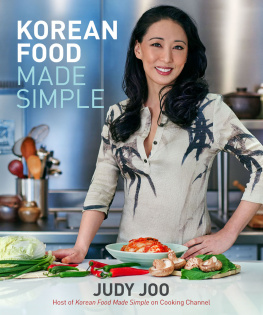EASY KOREAN RECIPES
Healthy Korean Recipes
By Ellen Kwon
Contents
Delicious Spinach
Korean Ramyun
Korean Potatoes
Easy Bean Sprouts
Spicy Cucumber
Shredded Green Onion Salad
Stuffed Chilli Peppers
Grilled Pork Belly Bites
Stir fried Green Beans
Quick Spicy Cabbage Salad
Korean Pancakes
Stir fried Sausage
Fiery Korean Ricecakes
Soybean Stew
Army Base Stew
Stir fried Squid
Fried Kimchi Rice
Spicy Korean Salad
Easy Bibimbab
Fresh Dressed Tofu
Spicy Fried Kale
Preface
My great aunt who lived to be over 101 years old and died in 2008 lived through Korea's most tumultuous century. She lived through the Japanese occupation, the second world war, the korean war, the military dictatorship of the sixties and 70s, the political upheaval that led to democracy in the 80s all the way into the new millenium working up until 2001 in a family run restaurant. I could almost say she lived many lives. Although she was born in what is now North Korea in the coastal town of Nampo, not far from Pyongyang she moved to Seoul later with husband. Then sometime after the korean war she settled in Jeollanam Do province in the very south of the country where she remained until she died. Many of the recipes in this book are ones I learned from her.
She was a fiery character to the end.
Living through a century of difficult times moving all over Korea my great aunt is the pinnacle of what Korean cuisine stands for. Fiery, traditional, dynamic and everlasting. At times in her life she lived in abject poverty with nothing but boiled tree bark to eat, at others she lived in times of plenty with a big belly as the fruits of Korea's economic miracle helped the country grow richer. Working in the cooking trade all her life my great aunt has truly become an expert at using the ingredients around her in the land. I am grateful I got to spend Seven of her formative years with her where I learned not just about korean history but I learned to recconect with my Korean Identity.
My name is Ellen Kwon and my parents emigrated to the United Kingdom before returning to Korea to retire and live with their family. As a Korean-British with dual nationality it was hard to find my true identity. Did I belong to the new found land of Afternoon tea and Scones where my parents moved to offer me a new life or did I belong to Korea where my ancestoral routes were held? After graduating university in London I was at a crossroads and decided to move back to Korea where I reconnected with my family and discovered the wonder that is Korean cooking.
I want to use this opportunity to acknowledge that through this recipe book the story of my great aunt will live on. These recipes are my way of carrying on her legacy and giving me the important realisation of what it means to be Korean. Now pregnant with my first child I hope that one day I can pass down these recipes to let them know what it means to be korean.
Please enjoy this book and everything that it means. I hope that with these recipes you can stay healthy and happy in these troubled times.
Introduction
I grew up as a Korean British immigrant in the United Kingdom. Finally after university I went a bit soul searching and naturally returned to my homeland where I discovered my heritage which I was never proud of and embarrassed. Gradually over the years I stayed in Korea I learned about my own Identity and appreciated my parents and learned to be proud of myself. I also learned about Korean cuisine through my Great aunt who taught me her wise ways and treasured recipes.
After living for 7 years in Korea, my great Aunt passed away and even though she had lived for many years I only met her in her last. She taught me more than how to cook the food of my motherland, she taught me about my identiy. I felt like it was my duty to introduce you to korean food just like I discovered it myself.
Need To Know
I am going to make reference to a few different terms and introduce a few ingredients you might not be familiar with so here is a 'need to know' introduction to korean cuisine
Kimchi
Korea's National side Dish consisting primarily of napa cabbage, red pepper flakes and garlic. Together with regional variations the dish is traditionally made around the fall and stored for the year ahead. This is an integral dish within Korean cuisine, incorporated into many other dishes or just served on its own alongside other dishes. It is known for its antibiotic health benefits and recently considered a superfood in the west.
Gochujang
This is the name of the fiery paste used in many Korean dishes. It is mixed and sweetened and includes red pepper flakes. Although it is not a deep burning heat it does provide that sweet yet spicy kick that most Korean dishes are known for.
Doenjang
Doenjang is a form of fermented soybeans formulated into a paste. It is a byproduct of soy sauce but in Korean cuisine is the base of many stews and other dishes. It has a distinctive smell and flavour often considered a good substitute for meat flavour. This same flavour adds a depth to any soup or stew making it richer and more savoury. It goes well with many meats and vegetables.
Gochugaru
Gochugaru is another name for Korea's distinctive red pepper flakes. Adding a spoonful or two of these mesmerizingly red flakes to your dish can really amp up the spiciness. It also is used alongside Gochujang paste for many dishes as it brings out the flavour of many ingredients. It is commonly made by each home in Korea so finding it in a Korean supermarket is rare and if you do it's often very expensive. Finding it in an asian supermarket outside of Korea is much easier.
Silky Tofu
Silky tofu is not as common as the former version more available outside of Korea and other asian countries. It is a perfect dish for spicy stews and even just dressing it as a salad. It can be found on korean tables at breakfast time as a suitable provision of protein. It tends to be cheaper than its firmer sister but personally I find it a lot tastier.
Ramuyn
Korean ramen is known as Ramyun. You will know which one it is on a shelf in the supermarket not by the korean writing but how spicy they tend to be. The noodles themselves are small and curly and are thought to be of superior quality to other instant noodles on the supermarket shelves. Koreans love instant ramyun and usually add eggs, meat or vegetables to it to make it more of a substantial meal.
Pork Belly
This is a more common cut of meat in Korea. Koreans love Samgyeopsal which is a dish consisting of grilled pork belly. The advantage of this in the UK for example is that because this cut of meat is not as popular it tends to be cheaper. The layers of fat on this meat are also a reason it is not so popular. However keep the fat on the pork belly and cook it the Korean way like I suggest in this book. You will be surprised just how tasty this meat it. The fat on the pork belly is known as the golden layers of flavour.


